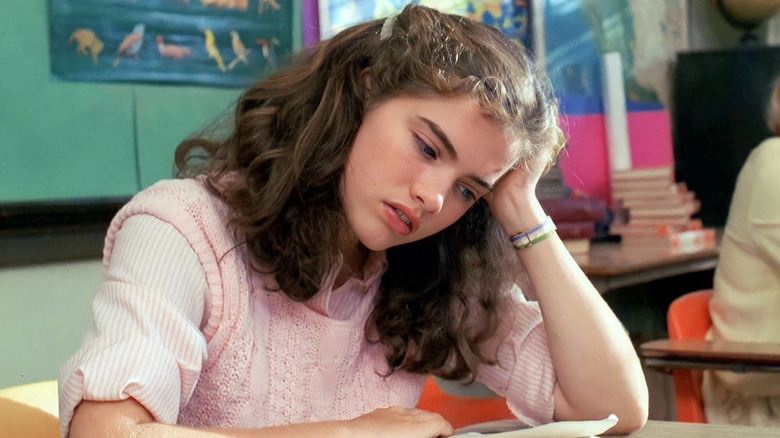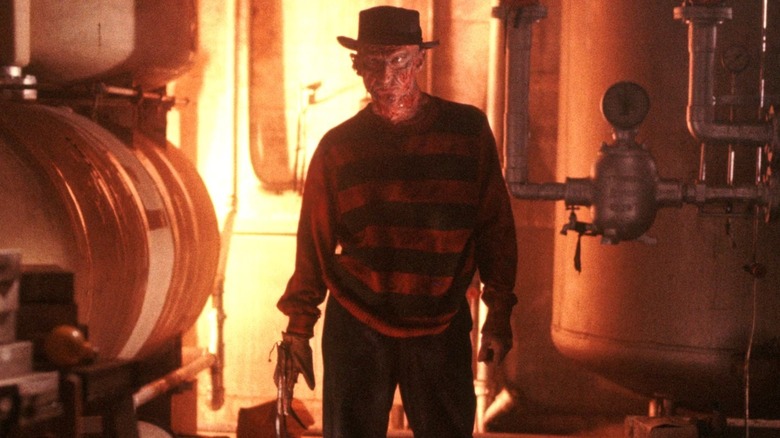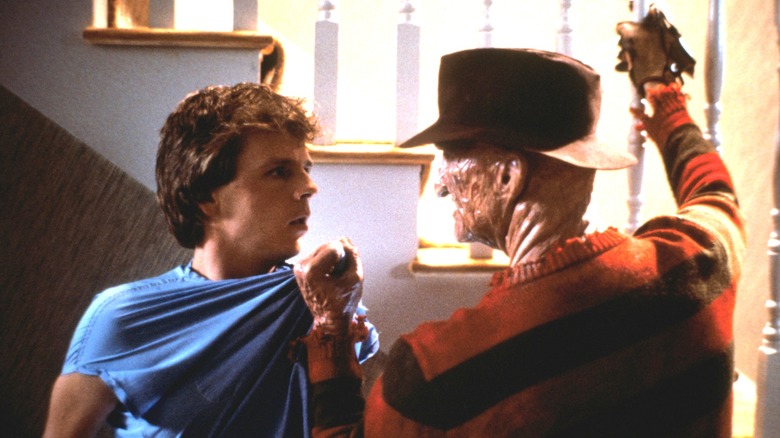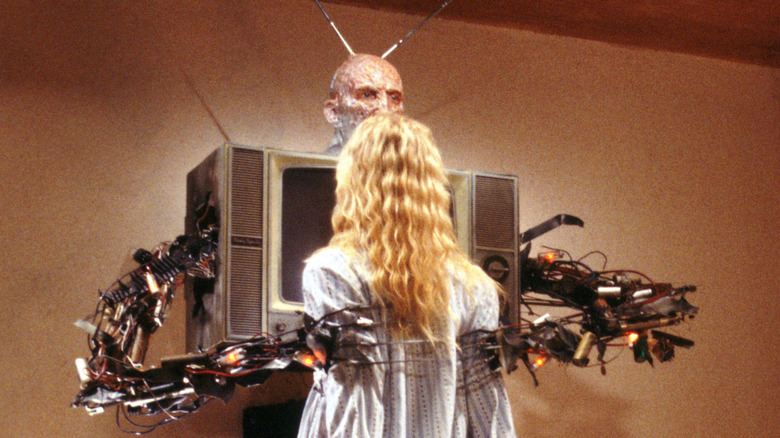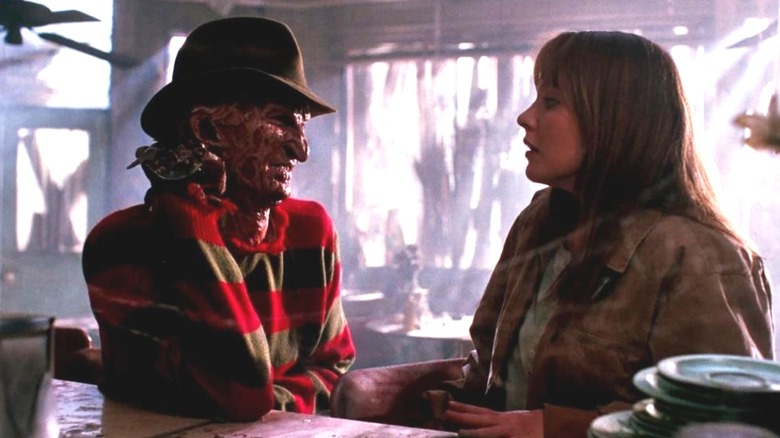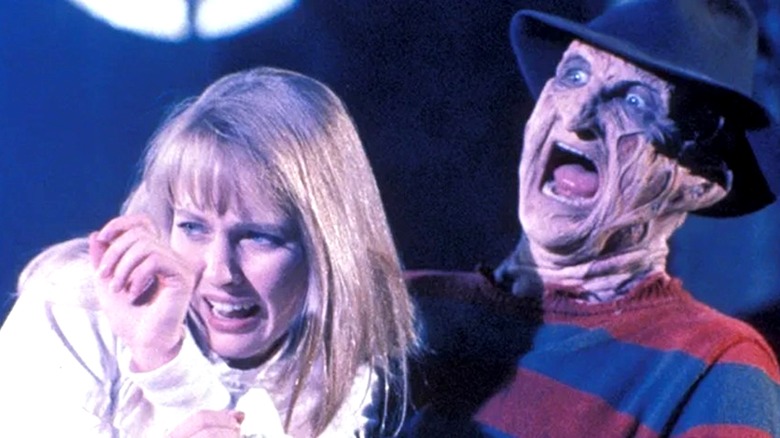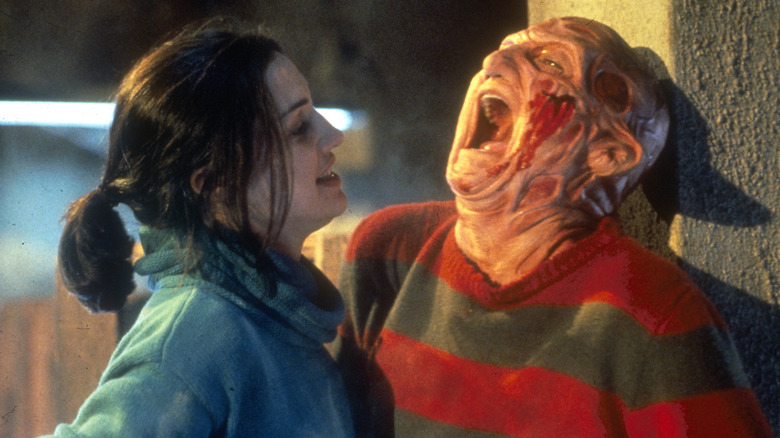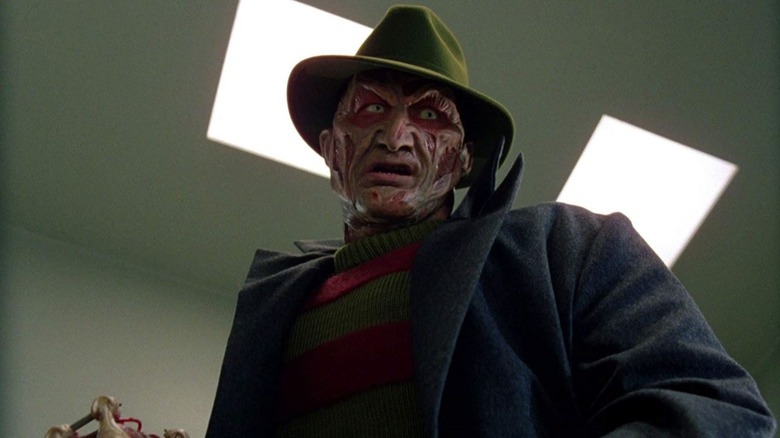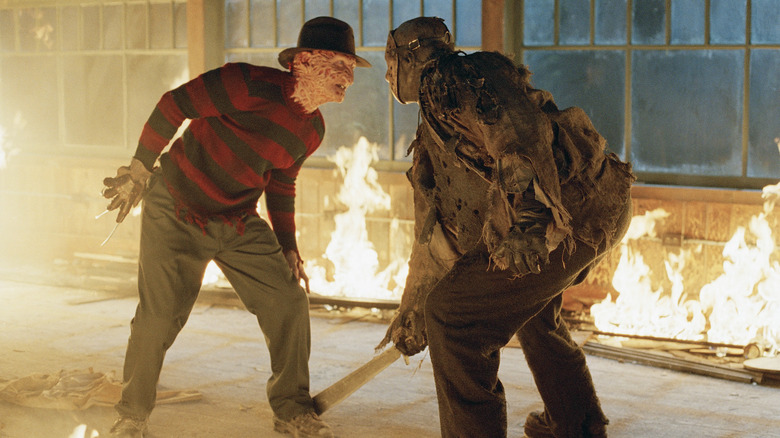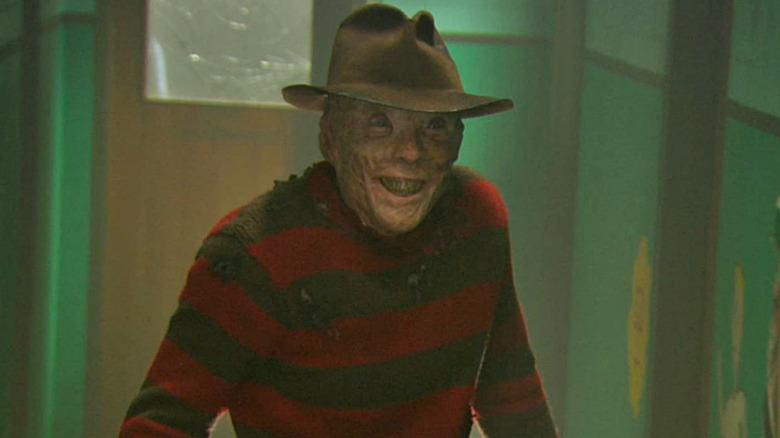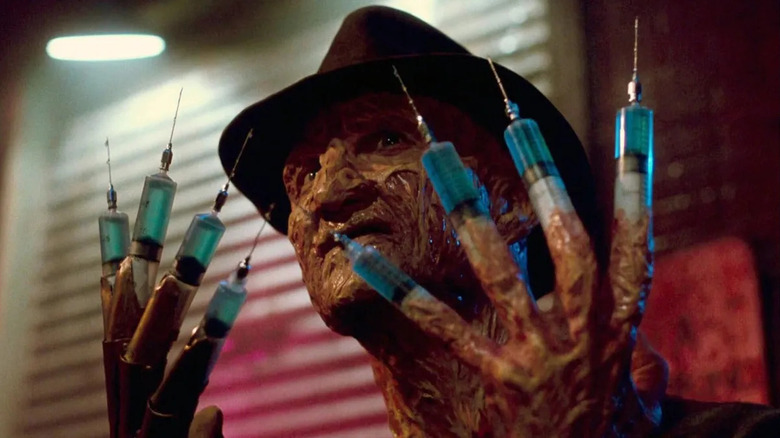How To Watch The Nightmare On Elm Street Movies In Order
"A Nightmare on Elm Street" blurs the line between our dreams and reality with a horror antagonist who has become known for his ragged striped sweater and clawed glove. Wes Craven's 1984 film spawned a franchise for Freddy Krueger, the man who invades the dreams of teens and makes them question everything they thought they knew before killing them in endlessly creative and violent ways.
Across nine entries, audiences have watched multiple groups of teenagers as they fight against Freddy, doing what they can to beat him down and prevent him from coming back. But, like any horror villain in a slasher series, he always finds a way to return. His need for revenge against the people of Springwood, Ohio, fuels him to continue to worm his way into their dreams, since he'll stop at nothing to have the last word. There's even a meta installment that sees him going after an actor from the film that started it all.
Some "Elm Street" movies are better than others, but there is a specific way to watch them for maximum effect. If you aren't sure where to start watching the franchise, never fear. This is the best way to watch them so you experience the story in order and have all the information you need as you make your way deeper and deeper into dreamland:
- "A Nightmare on Elm Street" (1984)
- "A Nightmare on Elm Street 2: Freddy's Revenge"
- "A Nightmare on Elm Street 3: Dream Warriors"
- "A Nightmare on Elm Street 4: The Dream Master"
- "A Nightmare on Elm Street 5: The Dream Child"
- "Freddy's Dead: The Final Nightmare"
- "Wes Craven's New Nightmare"
- "Freddy vs Jason"
- "A Nightmare on Elm Street" (2010)
Why is this the correct order to watch the Nightmare on Elm Street series?
Unlike some horror franchises, each of "A Nightmare on Elm Street" film picks up where the previous one left off, making the release order also the chronological order of the overall story. Because the characters build on each other, typically appearing in the next film to continue their fight against Freddy or to help the next group of teens in their final moments, it makes sense to watch the series in the order it was released.
Watching in this order also allows you to follow Freddy's story from the beginning, watching as he grows more and more desperate to enact his revenge on the residents of Springwood. The lengths he's willing to go to in order to get that chance grow more and more drastic as the franchise continues, requiring you to watch each chapter, in order, without skipping any of them. If you go straight from the original movie to, say, "The Dream Child," the level of his antics won't be as impactful and will likely come across as a bit silly rather than a continued upping of the ante as he fails again and again.
A Nightmare on Elm Street (1984)
To properly watch the series, you have to begin with the original movie. "A Nightmare on Elm Street" came out in 1984, during the height of the '80s horror slasher era. It follows teens Nancy (Heather Langenkamp), Glen (Johnny Depp, in his film debut), and Rod (Nick Corri) after their friend Tina (Amanda Wyss) is killed in her sleep by an unseen force. After Rod is arrested for murder (he was with Tina when she died), he, Nancy, and Glen begin having dreams of a disfigured man with blades for fingers. This begins a fight to the death as Nancy learns more about the man she can't get out of her head, why he's targeting her and her friends, and how he's connected to their hometown of Springwood.
Watching "A Nightmare on Elm Street" first is mandatory because it sets up the premise of the franchise and introduces audiences to two characters who will continue to appear throughout the series: Nancy and Freddy Krueger (Robert Englund), the dream killer. It sets the course for where the next installments will go, shows the level and type of danger the teens are in, and reveals what the community knows about him. Freddy's tactics and history are all on full display, giving audiences plenty of reasons to root against him and hope the teens can banish him for good.
A Nightmare on Elm Street 2: Freddy's Revenge
"A Nightmare on Elm Street 2: Freddy's Revenge" is the movie to watch next. Taking place five years after the events of the first film, it follows a new teen living in Nancy's old house. Jesse (Mark Patton) begins having strange dreams, and, after finding Nancy's diary in his room — her former room — he begins to understand what he's up against. Freddy becomes more of a corporeal being in this installment, moving outside of the home, showing how his power can grow when the teens' fear of him intensifies. However, this change doesn't stop Jesse and his friend Lisa (Kim Myers) from ultimately defeating the dream killer.
"Freddy's Revenge" shows audiences where Freddy went in the years after he was seemingly defeated by Nancy and illustrates his tenacity and endurance when it comes to continuing to seek vengeance against those who he feels have wronged him. It may take a while, but Freddy eventually reappears in the Springwood community's dreams, setting the precedent that it will take quite a bit to quiet him for good. The sequel also perfectly sets the stage for the events that come next in the franchise, including his ability to manipulate someone's body in the real world. While Freddy has what he feels is a justifiable reason to go after Nancy and her friends, Jesse is just in the wrong house at the wrong time when the killer makes his return and continues his quest for revenge.
A Nightmare on Elm Street 3: Dream Warriors
You should continue to watch the series in both release and chronological order with 1987's "A Nightmare on Elm Street 3: Dream Warriors." Set one year after the events of "Freddy's Revenge," making it six years since Nancy first defeated Freddy, Kristen (Patricia Arquette), another Springwood teen, begins having odd dreams. Rather than being left to deal with them on her own, Kristen's mother sends her to a psychiatric hospital out of concern for her health. Lucky for Kristen, Nancy is completing an internship here as she works toward becoming a therapist. Thus, she's able to help the teenager defeat Freddy, even if it's at the expense of her own life's plans.
Watching "Dream Warriors" at this point makes sense because Freddy's lore has been laid out, his relationship with Nancy is clear, and the fact that she didn't defeat him for good in their first battle has already been firmly established. There are ties back to the group of vigilantes who burned Freddy when he was human, showing that the killer is only trying to finish the work he started with Nancy.
Originally intended to be the franchise's final entry, "Dream Warriors" provides redemption for Nancy and shows how she's grown while setting up the next group of teens to carry on her legacy. Without understanding everything Nancy went through in the original movie, her sacrifice in "Dream Warriors" isn't nearly as impactful.
A Nightmare on Elm Street 4: The Dream Master
"A Nightmare on Elm Street 4: The Dream Master" takes place a year after the events of "Dream Warriors" and continues Freddy's murderous saga. The teens from the last film's psychiatric hospital are back home, living their lives, when the dreams begin again. Though Joey (Rodney Eastman) and Kincaid (Ken Sagoes), both introduced in "Dream Warriors," don't believe Kristen's (now played by Tuesday Knight) claims that Freddy has returned, things take a turn for the worse when the dream killer starts picking them off one by one. Alice (Lisa Wilcox), Kristen's boyfriend's sister, becomes a key part of the narrative, trying to fight against Freddy after the "Dream Warriors" teens die.
"The Dream Master" is interesting in that Kristen's final girl survivor status is revoked, much like Nancy's was in "Dream Warriors." The fourth film also takes more chances with the narrative, reinforcing that no one is truly safe from Freddy and that Nancy's death isn't a one-off shock. Even if you understand what's going on and have previously defeated him, Freddy remains extremely dangerous. It also firmly presents the concept of transference and the ability to not only pull others into dreams in a controlled manner but also that the power can be given to someone else to save others. While this idea is introduced in "Dream Warriors," "The Dream Master" builds on that information and establishes new lore for the franchise. Without watching the films before this one, the characters and their abilities are more likely to appear to the audience as nonsensical rather than logical evolutions.
A Nightmare on Elm Street 5: The Dream Child
Continuing the trend of the franchise's "one year later" timeline jumps, "A Nightmare on Elm Street 5: The Dream Child" picks up with Alice after the events of "Dream Master." Her dreams have returned, but there is a more concerning nature to them, with religious ideology and frequent appearances of a child. This time, Freddy is determined to return to the world with a physical body, and Alice's pregnancy seems like his way to do it. The movie features Alice fighting not only for the lives of her and her friends but her unborn child's as well.
Much like the other films, "The Dream Child" was released as the fifth installment and should be watched in that same order. It builds not only on the character journeys of the movies that came before it but also on Freddy's own uniquely insidious nature. "The Dream Child" also marks a shift in tone for the franchise, coming across as more sinister and dark. This is especially visible in the introduction of the idea that Freddy wants to take over the body of an unborn child as a way to return to the physical world; he's no longer content to be a manifestation of fear or to take temporary control of a teenager's body. "The Dream Child" continues to tweak what we know about Freddy and his powers, and without the prior context of Alice's abilities presented in "The Dream Master," how she's able to protect herself and her baby won't make sense to viewers.
Freddy's Dead: The Final Nightmare
Though a decade has now passed in the "Nightmare on Elm Street" timeline, Freddy returned to theaters two years after "The Dream Child" was released with "Freddy's Dead: The Final Nightmare," the franchise's sixth chapter. Without a main character like Nancy, Kristen, or Alice to keep him in check, the dream killer has spent the last ten years taking revenge on nearly everyone in town — except for a teen with no memory of who they are. After John Doe (Shon Greenblatt) ends up at a shelter, a newspaper clipping sends him, the adult responsible for looking after him, and three teens who are eager to head to California on a path toward Springwood. While Dr. Maggie Burroughs (Lisa Zane) believes visiting the Ohio town could jog John's memory, the truth is that they're all walking into a bloodbath. What follows is a journey to determine which of these characters is related to Freddy and where the killer's power actually comes from.
Though "The Final Nightmare" involves a significant time jump, especially compared to the previous installments, you need to have the foundational viewing of the other films to understand why Freddy's actions have escalated to this point and why he has a vendetta against the town. While some of that information can be inferred from "The Final Nightmare's" script, watching it with the knowledge from the previous films in mind makes the movie easier to understand and immerse yourself in.
Wes Craven's New Nightmare
"A Nightmare on Elm Street" went meta for its next chapter, "Wes Craven's New Nightmare." With this film, Craven returned to Freddy's world to create a story showing where the original film's star, Heather Langenkamp, is in life and her career after the success of the franchise. Not only does she deal with unsavory fans, Freddy makes the jump from movies to the "real world" as he starts to appear in her and her son Dylan's (Miko Hughes) dreams.
While "New Nightmare" isn't necessary viewing by any means, if you do choose to watch it, it's best to do so after experiencing the first six films, especially because the ending of "The Final Nightmare" directly addresses how Freddy can make the jump from movies to real life. In addition to that film setting the stage for his appearance in Langencamp's life, it's important to understand just how long it took Freddy to achieve this. He's been trying to figure this trick out for decades at this point, and while Springwood's teens think they've destroyed him for good, they've actually unintentionally enabled him to do exactly what he wanted. And, since Langenkamp isn't the only person from the franchise to star in this movie as themself, it's also important to watch what came first so you can recognize the cameos as they come up.
Freddy vs. Jason
Cast back into the fictional realm, Freddy is ready to take on another horror movie legend: Jason Voorhees, from the "Friday the 13th" franchise. Now, Freddy has been unable to enter dreams due to the medication used by Springwood's residents, so he decides the next best plan is to pretend to be Jason's mother, Pamela, to lure the machete-wielding force of nature in to kill the town's residents. Though he doesn't intend to fight Jason, Freddy is forced to do exactly that when the film's teenage protagonists take him to Camp Crystal Lake, Jason's traditional haunt, as a way to keep him from returning to his beloved/hated town.
Like "New Nightmare," "Freddy vs. Jason" isn't mandatory to watch, but it's a fun way to end Freddy's canon in the original franchise's timeline. It actually marks an end for both villains before their franchises get rebooted and is also an awesome showdown between two major slasher villains. Like other "Nightmare on Elm Street" movies, the way the teens outwit Freddy not only shows their knowledge of who's lurking in their backyard (and dreams), it also creates one of the best battles in the genre's history.
A Nightmare on Elm Street (2010)
The final movie to watch is the remake of the original. This version of "A Nightmare on Elm Street" came out in 2010, effectively starting a new story that isn't connected to the previous eight films. It follows a similar story, with Nancy, this time portrayed by Rooney Mara, trying to understand who Freddy, played here by Jackie Earle Haley, is and how to defeat him before all her friends die. It even mimics the ending of the 1984 version, with Nancy's mother being killed by Freddy as a hint of what had been planned to come.
While it isn't necessary to watch the remake, it's a fun way to see how special effects have evolved in film over time. The 2010 version is the only one in its continuity, meaning it's easy to omit it if you want to focus solely on the original "Nightmare on Elm Street" timeline. For completists, this is the one to watch at the end because it's the start of something new rather than a continuation of the original franchise. The remake also presents a slightly new look for Freddy, specifically with his facial scars, though it never quite caught on in the pop culture zeitgeist.
Is there another way to watch the Nightmare on Elm Street series?
There are a few different ways to watch the franchise if you don't want to follow the release order. The next best way to watch the series is to watch just the original, "Dream Warriors," "The Dream Master," "The Dream Child," and "New Nightmare." This gives you a Nancy-centric storyline, starting with her story and then the individuals she helps in "Dream Warriors" and their stories after. It ends with the meta film pitting Heather Langenkamp against Freddy, completing her arc. This can even be shortened to watching the first movie, "Dream Warriors," and "New Nightmare" if you want to focus solely on the films with Nancy or Heather Langenkamp in them.
Horror fans can also watch the "Nightmare on Elm Street" entries in chronological order while peppering in the "Friday the 13th" films in their respective release order, going back and forth between them until you reach "Freddy vs. Jason." This gives you the complete picture going into their epic battle. You can also add in the documentary "Never Sleep Again: The Elm Street Legacy," which came out in 2010, to learn more about the entire "Nightmare on Elm Street" series and get a behind-the-scenes look at every film but the 2010 remake. While it isn't required, it can enrich the overall viewing experience.
You can also watch the franchise as sets of trilogies. The most obvious combination is "Freddy's Revenge," "Dream Warriors," and "The Dream Master," three films that work as a trilogy since they all take place within a year of each other. Another possible trilogy viewing can be crafted by focusing on "The Dream Master," "The Dream Child," and "The Final Nightmare."
